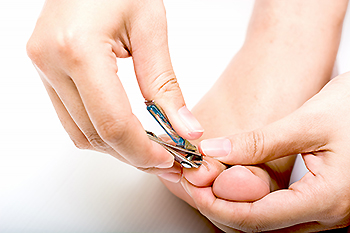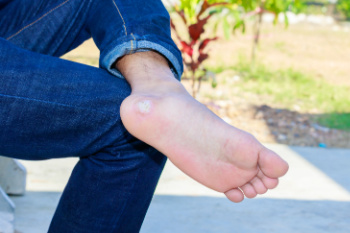NJ (908) 688-5577
NY (212) 737-2528

Proper toenail care is important for maintaining foot health and preventing issues like ingrown toenails and infections. Start by soaking your feet in warm water for about 10 minutes. This softens the nails, making them easier to cut and reducing the risk of cracking. Use a high-quality nail clipper or scissors specifically designed for toenails, as regular fingernail clippers may not provide a clean cut. When trimming, cut the toenails straight across rather than rounding the edges. This approach helps to prevent ingrown toenails, which occur when the nail grows into the surrounding skin. Avoid cutting the nails too short, leaving a small white edge at the tip to prevent discomfort and reduce the risk of infection. After cutting, smooth any rough edges with a nail file to avoid snags and cuts. If you need help with problematic toenails, it is suggested you schedule an appointment with a podiatrist.
Ingrown toenails can become painful if they are not treated properly. For more information about ingrown toenails, contact Glenn Davison, DPM of Advanced Podiatry. Our doctor can provide the care you need to keep you pain-free and on your feet.
Ingrown Toenails
Ingrown toenails occur when a toenail grows sideways into the bed of the nail, causing pain, swelling, and possibly infection.
Causes
Prevention
Because ingrown toenails are not something found outside of shoe-wearing cultures, going barefoot as often as possible will decrease the likeliness of developing ingrown toenails. Wearing proper fitting shoes and using proper cutting techniques will also help decrease your risk of developing ingrown toenails.
Treatment
Ingrown toenails are a very treatable foot condition. In minor cases, soaking the affected area in salt or antibacterial soaps will not only help with the ingrown nail itself, but also help prevent any infections from occurring. In more severe cases, surgery is an option. In either case, speaking to your podiatrist about this condition will help you get a better understanding of specific treatment options that are right for you.
If you have any questions please feel free to contact our offices located in Union, NJ and New York . We offer the newest diagnostic and treatment technologies for all your foot and ankle needs.

Choosing the right walking shoes is important for comfort and injury prevention, as walking is an easy and inexpensive way to exercise. Unlike running shoes, walking shoes should provide specific features tailored to walking motions. Opt for motion-controlled shoes to enhance stability and prevent excessive foot movement. Ensure the shoes bend easily at the ball of the foot to facilitate natural walking motions. The insole should contour to your foot for added support, cushioning, and shock absorption. A snug heel fit is essential to prevent slipping, but it should not be tight to avoid discomfort. Additionally, the toe box should be spacious enough to allow your toes to move freely, preventing blisters and bunions. Investing in proper walking shoes will make your walks more enjoyable and beneficial. If you need further assistance in choosing the right walking shoes, it is suggested that you schedule an appointment with a podiatrist who can give you additional tips.
For more information about walking shoes versus running shoes, consult with Glenn Davison, DPM from Advanced Podiatry. Our doctor can measure your feet to determine what your needs are and help you find an appropriate pair of footwear.
Foot Health: The Differences between Walking & Running Shoes
There are great ways to stay in shape: running and walking are two great exercises to a healthy lifestyle. It is important to know that running shoes and walking shoes are not interchangeable. There is a key difference on how the feet hit the ground when someone is running or walking. This is why one should be aware that a shoe is designed differently for each activity.
You may be asking yourself what the real differences are between walking and running shoes and the answers may shock you.
Differences
Walking doesn’t involve as much stress or impact on the feet as running does. However, this doesn’t mean that you should be any less prepared. When you’re walking, you land on your heels and have your foot roll forward. This rolling motion requires additional support to the feet.
Flexibility – Walking shoes are designed to have soft, flexible soles. This allows the walker to push off easily with each step.
If you have any questions, please feel free to contact our offices located in Union, NJ and New York . We offer the newest diagnostic and treatment technologies for all your foot care needs.

Plantar warts can be both unsightly and painful. These small, hard growths on the bottom of the foot are usually harmless but highly contagious. They are caused by the human papilloma virus, or HPV, which can enter through a sore or crack in the skin. Plantar warts commonly appear on the heels and the fleshy parts of the toes. HPV thrives in damp environments, like public pools, showers, and gym locker rooms, so wearing protective footwear in these places is advised. It's also important to avoid touching the warts to prevent spreading the virus to other body parts. Treatment options for plantar warts include over-the-counter medications, liquid nitrogen to burn off the wart, or cryotherapy to freeze it. If you frequently get plantar warts, it is suggested you make an appointment with a podiatrist for a proper diagnosis and treatment.
Plantar warts can be very uncomfortable. If you need your feet checked, contact Glenn Davison, DPM from Advanced Podiatry. Our doctor will assist you with all of your foot and ankle needs.
About Plantar Warts
Plantar warts are the result of HPV, or human papillomavirus, getting into open wounds on the feet. They are mostly found on the heels or balls of the feet.
While plantar warts are generally harmless, those experiencing excessive pain or those suffering from diabetes or a compromised immune system require immediate medical care. Plantar warts are easily diagnosed, usually through scraping off a bit of rough skin or by getting a biopsy.
Symptoms
Treatment
To help prevent developing plantar warts, avoid walking barefoot over abrasive surfaces that can cause cuts or wounds for HPV to get into. Avoiding direct contact with other warts, as well as not picking or rubbing existing warts, can help prevent the further spread of plantar warts. However, if you think you have developed plantar warts, speak to your podiatrist. He or she can diagnose the warts on your feet and recommend the appropriate treatment options.
If you have any questions please feel free to contact our offices located in Union, NJ and New York . We offer the newest diagnostic and treatment technologies for all your foot and ankle needs.
 Hammertoe surgery is a procedure to correct a deformity where a toe bends downward abnormally. Before surgery, expect a thorough consultation with your podiatrist, including a physical examination and imaging tests to assess the extent of the deformity. The procedure is typically outpatient, meaning you can go home the same day. During surgery, you will receive local anesthesia to numb the area. The doctor may remove a small piece of bone or realign tendons and ligaments to straighten the toe. Post-surgery, your foot will be bandaged, and you may need to wear a special shoe or boot for several weeks to protect the toe. Recovery involves rest, keeping your foot elevated, and avoiding putting weight on the affected area initially. Pain and swelling are common but manageable with prescribed medications. If you have had hammertoe surgery, follow-up appointments with a podiatrist are strongly suggested to monitor healing.
Hammertoe surgery is a procedure to correct a deformity where a toe bends downward abnormally. Before surgery, expect a thorough consultation with your podiatrist, including a physical examination and imaging tests to assess the extent of the deformity. The procedure is typically outpatient, meaning you can go home the same day. During surgery, you will receive local anesthesia to numb the area. The doctor may remove a small piece of bone or realign tendons and ligaments to straighten the toe. Post-surgery, your foot will be bandaged, and you may need to wear a special shoe or boot for several weeks to protect the toe. Recovery involves rest, keeping your foot elevated, and avoiding putting weight on the affected area initially. Pain and swelling are common but manageable with prescribed medications. If you have had hammertoe surgery, follow-up appointments with a podiatrist are strongly suggested to monitor healing.
Foot surgery is sometimes necessary to treat a foot ailment. To learn more, contact Glenn Davison, DPM of Advanced Podiatry. Our doctor will assist you with all of your foot and ankle needs.
When Is Surgery Necessary?
Foot and ankle surgery is generally reserved for cases in which less invasive, conservative procedures have failed to alleviate the problem. Some of the cases in which surgery may be necessary include:
What Types of Surgery Are There?
The type of surgery you receive will depend on the nature of the problem you have. Some of the possible surgeries include:
Benefits of Surgery
Although surgery is usually a last resort, it can provide more complete pain relief compared to non-surgical methods and may allow you to finally resume full activity.
Surgical techniques have also become increasingly sophisticated. Techniques like endoscopic surgery allow for smaller incisions and faster recovery times.
If you have any questions please feel free to contact our offices located in Union, NJ and New York . We offer the newest diagnostic and treatment technologies for all your foot and ankle needs.